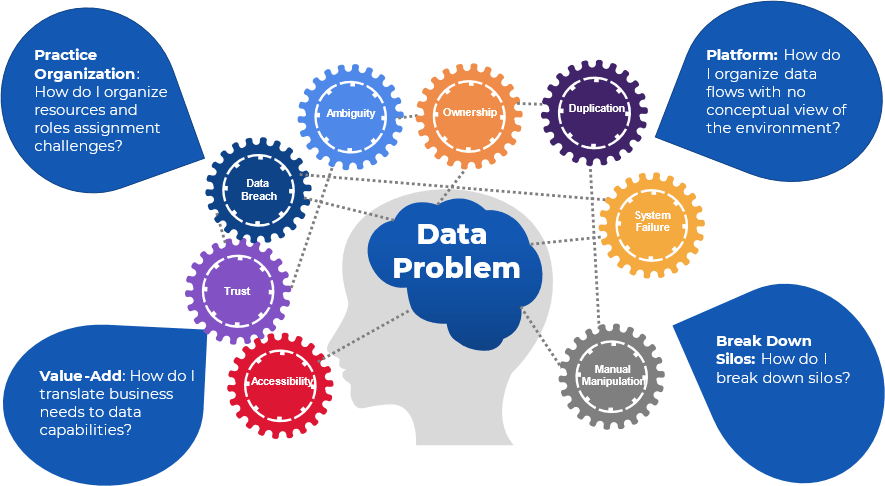The complex nature of data investment leads to de-scoping and delivery of data services that do not meet business needs or give value to the business. Subject matter experts are hired to resolve the problem, but their success is impacted by absent architecture, technology, and organizational alignment.
Our Advice
Critical Insight
Walking through a book of architecture building plans with a personal guide is cheaper and faster than employing an architect to build and design your home.
Impact and Result
Info-Tech's approach provides a proven methodology that includes the following:
- Business-aligned data initiatives and capabilities that address data challenges and realize business strategic objectives.
- Comprehensive data practice designed based on the required business and data capabilities.
- Data platform design based on Info-Tech data architecture reference patterns and prioritized data initiatives and capabilities.
Workshop: Build Your Data Practice and Platform
Workshops offer an easy way to accelerate your project. If you are unable to do the project yourself, and a Guided Implementation isn't enough, we offer low-cost delivery of our project workshops. We take you through every phase of your project and ensure that you have a roadmap in place to complete your project successfully.
Module 1: Establish Business Context and Value
The Purpose
Establish business context and value.
Key Benefits Achieved
Business context and strategic driver.
Activities
Outputs
Understand/confirm the organization's strategic goals
- Business context and strategic drivers
Classify the strategic goals and map to business drivers
- Prioritized business capabilities and processes
Identify the business capabilities that the strategy focuses on
- Data culture survey results analysis
Identify the business processes realizing the strategy
Module 2: Identify Your Top Initiatives
The Purpose
Identify your top initiatives.
Key Benefits Achieved
High-value business-aligned data initiative.
Activities
Outputs
Highlight data-related outcomes/goals to realize to fulfill the business goal
- High-value, business-aligned data initiatives
Map business data initiatives to the business strategic goals
Prioritize data initiatives
Module 3: Analyze Data Challenges
The Purpose
Analyze data challenges.
Key Benefits Achieved
Clear understanding of the data challenges.
Activities
Outputs
Map data challenges to Info-Tech data challenges
- List of data challenges preventing data maturation with the organization
Review Info-Tech data capabilities based on prioritized initiatives
Discuss data platform and practice next steps
Module 4: Map Data Capability
The Purpose
Map data capability.
Key Benefits Achieved
Prioritized data capability.
Activities
Outputs
Map data challenges to Info-Tech data challenges
- Required data capabilities
Review Info-Tech data capabilities based on prioritized initiatives
- Data platform and practice – plan
Discuss data platform and practice next steps
- Initialized data management RACI
















 Establish an Analytics Operating Model
Establish an Analytics Operating Model
 Create and Manage Enterprise Data Models
Create and Manage Enterprise Data Models
 Build a Robust and Comprehensive Data Strategy
Build a Robust and Comprehensive Data Strategy
 Mandate Data Valuation Before It’s Mandated
Mandate Data Valuation Before It’s Mandated
 Position and Agree on ROI to Maximize the Impact of Data and Analytics
Position and Agree on ROI to Maximize the Impact of Data and Analytics
 Create a Data Management Roadmap
Create a Data Management Roadmap
 Establish Data Governance
Establish Data Governance
 Build a Data Architecture Roadmap
Build a Data Architecture Roadmap
 Build a Data Integration Strategy
Build a Data Integration Strategy
 Build a Data Pipeline for Reporting and Analytics
Build a Data Pipeline for Reporting and Analytics
 Build an Extensible Data Warehouse Foundation
Build an Extensible Data Warehouse Foundation
 Build Your Data Quality Program
Build Your Data Quality Program
 Build a Reporting and Analytics Strategy
Build a Reporting and Analytics Strategy
 Mitigate Machine Bias
Mitigate Machine Bias
 Design Data-as-a-Service
Design Data-as-a-Service
 Create an Architecture for AI
Create an Architecture for AI
 Get Started With Artificial Intelligence
Get Started With Artificial Intelligence
 Go the Extra Mile With Blockchain
Go the Extra Mile With Blockchain
 Understand the Data and Analytics Landscape
Understand the Data and Analytics Landscape
 Select Your Data Platform
Select Your Data Platform
 Build Your Data Practice and Platform
Build Your Data Practice and Platform
 Establish Data Governance – APAC Edition
Establish Data Governance – APAC Edition
 Foster Data-Driven Culture With Data Literacy
Foster Data-Driven Culture With Data Literacy
 Generative AI: Market Primer
Generative AI: Market Primer
 Establish Effective Data Stewardship
Establish Effective Data Stewardship
 Identify and Build the Data & Analytics Skills Your Organization Needs
Identify and Build the Data & Analytics Skills Your Organization Needs
 Promote Data Literacy in Your Organization
Promote Data Literacy in Your Organization